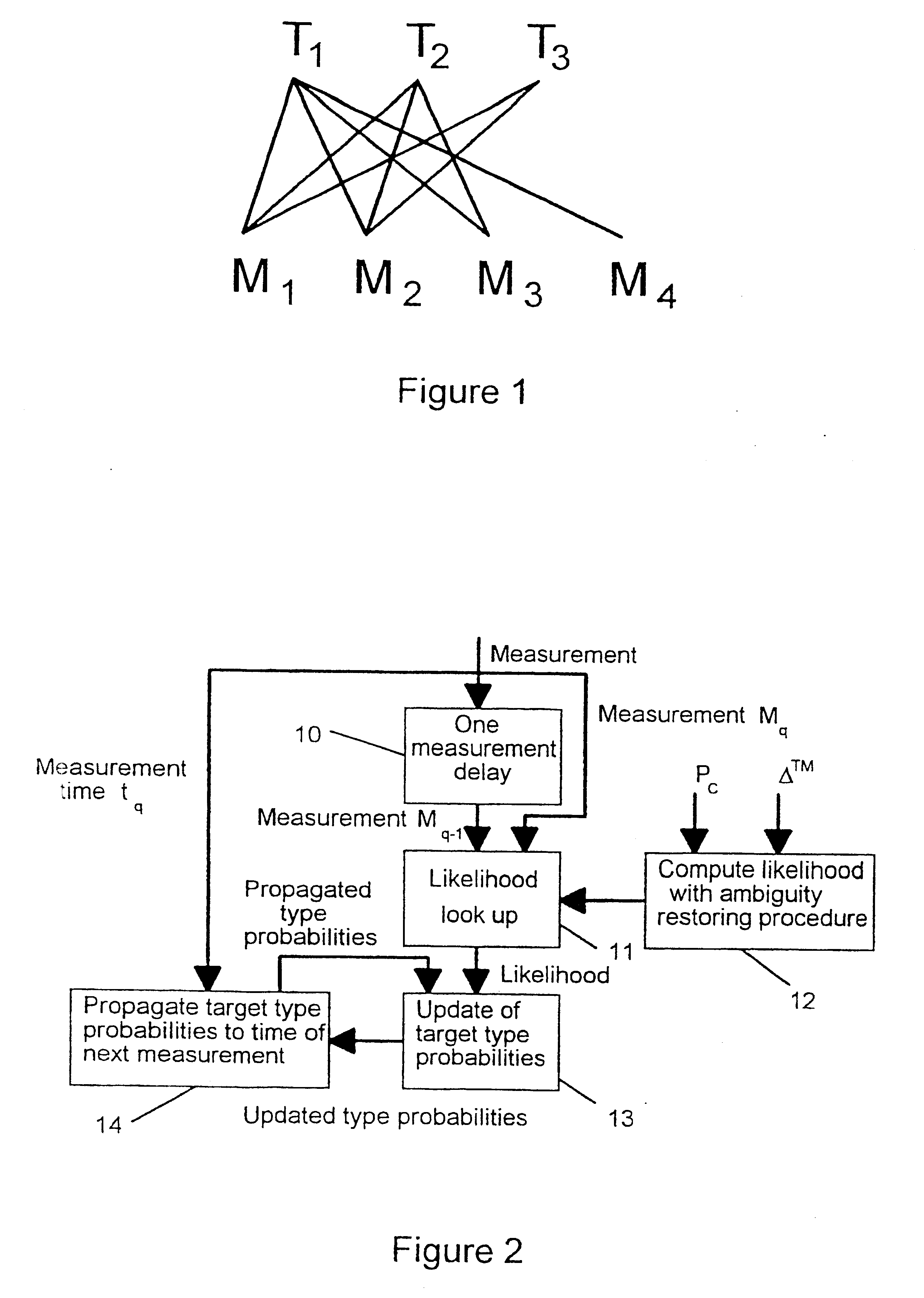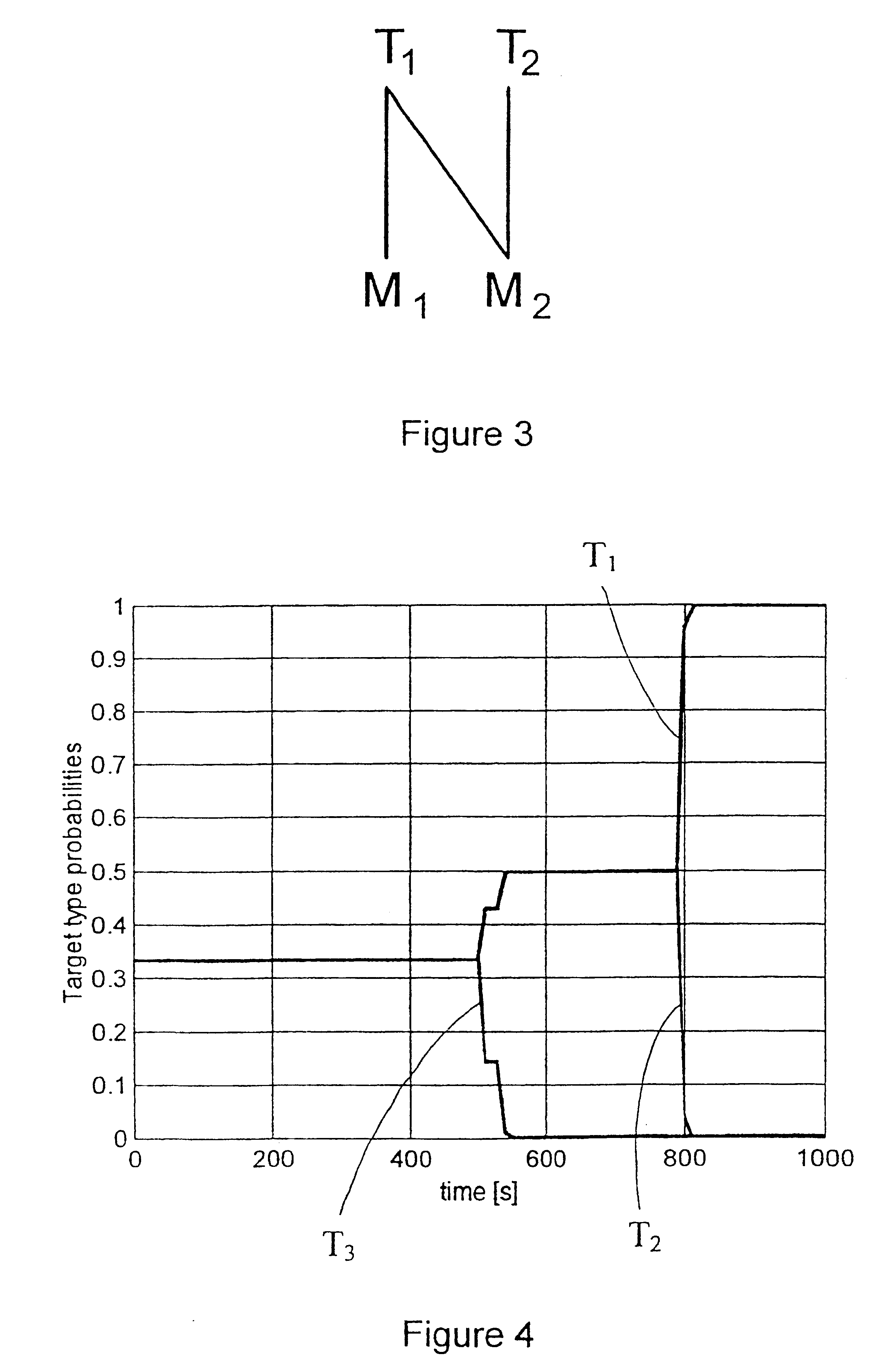Target type estimation in target tracking
a target type and tracking technology, applied in direction finders, radio wave direction/deviation determination systems, instruments, etc., can solve problems such as and affecting the accuracy of target type estimation
- Summary
- Abstract
- Description
- Claims
- Application Information
AI Technical Summary
Benefits of technology
Problems solved by technology
Method used
Image
Examples
example 2
A more relevant example of the above method is given by the situation defined by FIG. 1. The measurements are in this example ESM measurements and accordingly the measurement outcomes are emitter modes. The look-up table is thus a 3-dimensional data structure with dimension 4.times.3.times.4 and a 4.times.3 matrix. In order to visualise the data structure, each target type is illustrated separately, i.e. 3 separate matrixes 4.times.4 together with the 4.times.3 matrix. Target type 2 is selected as the designing target type. According to (2) and (3) the following parameters are obtained:
P.sub.C : user choice. ##EQU18##
The data structures become ##EQU19##
according to (4) and (5). In the three first equations above, M.sub.q runs over rows and M.sub.q- runs over columns. In the last equation above M.sub.q- runs over rows while T.sub.i runs over columns. Starting with P(t.sub.q,M.sub.q.vertline.T.sub.1,M.sub.q-1), a previous measurement outcome which is consistent with the considered tar...
example 3
In FIG. 5 an example of a target type system using IRST measurements is shown. Four target types are possible, T.sub.1 -fighter, T.sub.2 -bomber, T.sub.3 -fighter bomber and T.sub.4 -reconnaissance aircraft. The fighter can carry 6 missiles, the bomber is not equipped with missiles, the fighter bomber can carry 4 missiles and the reconnaissance aircraft can carry 2 missiles. Accordingly, 7 measurement outcomes are possible; M.sub.0 -0 missiles fired from the track, M.sub.1 -1 missile fired from the track, M.sub.2 -2 missiles fired from the track, M.sub.3 -3 missiles fired from the track, M.sub.4 -4 missiles fired from the track, M.sub.5 -5 missiles fired from the track, M.sub.6 -6 missiles fired from the track. The relation between target types and measurement outcomes is in his case given by the matrix: ##EQU20##
The approximation scheme described above can then be used.
In a preferred embodiment of the present invention, discrete measurements of different types are used together. If...
example 4
To illustrate the improvements that can be expected, FIGS. 7a and 7b show a scenario with two targets T1 and T2, where the filled shapes symbolises the different target types, and two measurements (strobes) S1 and S2 that are to be associated. The line extending from the target track indicates the velocity by the direction of this line. In FIG. 7a only kinematic information is used, i.e. no significance is paid to the target type information, while target type information is used in FIG. 7b. The angular accuracy's of the strobes are assumed to be significantly larger than the angular separation between the strobes. It can be seen that the association in FIG. 7a fails and associates strobe S1 to target track T1 and strobe S2 to target track T2. However, the additional information from the target type estimation, symbolised by the empty shapes at the end of the strobes, make a correct association possible in FIG. 7b, i.e associating strobe S1 to target track T2 and strobe S2 to target...
PUM
 Login to View More
Login to View More Abstract
Description
Claims
Application Information
 Login to View More
Login to View More - R&D
- Intellectual Property
- Life Sciences
- Materials
- Tech Scout
- Unparalleled Data Quality
- Higher Quality Content
- 60% Fewer Hallucinations
Browse by: Latest US Patents, China's latest patents, Technical Efficacy Thesaurus, Application Domain, Technology Topic, Popular Technical Reports.
© 2025 PatSnap. All rights reserved.Legal|Privacy policy|Modern Slavery Act Transparency Statement|Sitemap|About US| Contact US: help@patsnap.com



